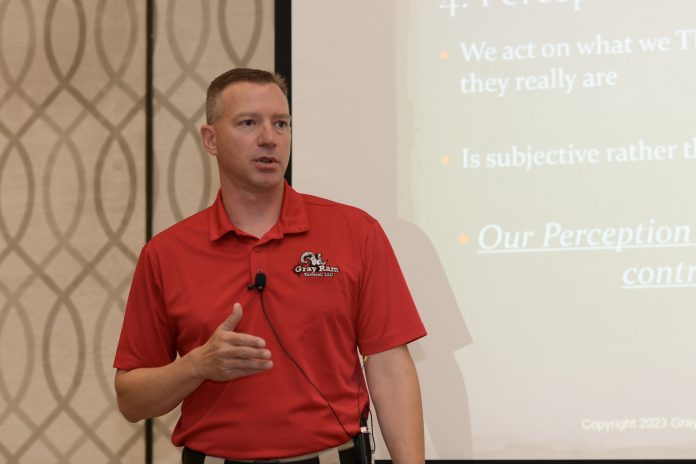De-escalation techniques were a hot topic at both STN EXPO Indy and Reno as student transporters prepared for the new school year.
After hearing behavior specialist Patrick Mulick at STN EXPO Indy in June discuss the stages of escalation and techniques to help de-escalate student riders, attendees at STN EXPO Reno last month were briefed by a law enforcement officer and military veteran on verbal and nonverbal de-escalation techniques.
Mulick shared the stages of de-escalation and what adults can do to help students. Mulick, who is also the assistant director of autism services for Auburn School District in Washington state, discussed five levels in depth on the progression of escalation: Calm, Trigger, Agitation, Acceleration, and Peak.
Related: Fan Favorite Mulick Provides Student Transporters Tips for De-Escalation
He added that the Three R’s of de-escalation are regulation, relationship and responsibility.
Meanwhile, Bret Brooks, a law enforcement and security expert, took a similar but slightly different approach to discuss de-escalation at STN EXPO in Reno, Nevada. Brooks, the senior consultant with Gray Ram Tactical and the training coordinator and policy advisor for the Missouri State Highway Patrol, explained how to spot indicators of violence and the proper ways to step in and use de-escalation techniques.
He explained that younger individuals will “test the waters” to determine what type of behavior they can get away with. He said the key is to stop the bad behavior during this phase. In order to do that, he said, one must interject themselves into the situation without getting the aggressor upset. And while Mulick provided tools for de-escalation mainly in terms of working with students, Brooks provided more general information that can be related to pupil transportation professionals and how these techniques could help with upset parents, for example.
Brooks broke down the various ways to do that, the first being speaking softly. One key phrase is to say, “Let me see if I got this right” and “Let me make sure I understand you,” repeating what the person is upset about. He advised setting up sentence structures with the first phrase being the most important aspect to the other person. For example, when he wants his own children to clean their room, he says, “Let’s get ice cream, but before we do that please clean your room.”
This ensures the individual hears the entire sentence. When looking at sentence structure, he also advised empathizing keywords, using simple words, and including words like “I,” “we,” “us” and people’s names.
10 Things Not to Say
10. Come here.
9. It’s none of your business.
8. You “never” or you “always”
7. I’m not going to say this again.
6. What do you want me to do about this?
5. I’m doing this for your own good.
4. What’s your problem?
3. You wouldn’t understand.
2. Because those are the rules.
1. Calm down.
The next step is using empathy, or understanding the conversation from the other person’s perspectiive, which he shared is difficult as we all get caught up in the moment. For instance, if a student wants off the bus, instead of instantly saying no ask the student why they want off the bus in the first place.
Next is perception. He said people act on what they perceive to be the facts, which might not be the reality. “Our perception dictates our attitude, which includes our behavior,” he explained. “Telling someone to change their attitude doesn’t work. You have to change their perception.”
For example, he said, if a student consistently stands up on the school bus before getting to the bus stop, a school bus driver could try explaining the consequences. “Every time you stand up before I come to a complete stop, I have to take my eyes off the road,” he suggested as a response. “If something runs out in front of me, I have to slam on the brakes, and that could hurt you.”
Then he discussed the most powerful sentence. “Is there anything I can say or do at this time to [address the student’s needs]? I would like to think that there is,” Brooks offered, adding that the question provides the person with a potential resolution to the issue.
Related: Law Enforcement Expert Shares Importance of Identifying Weapons on School Buses
Related: Identifying Risk Factors, Prevention Strategies Discussed at STN EXPO Reno
Related: School Bus Safety Seminar Provides Guidelines for Navigating Liability
Another tactic, he said, is to interpret their OODA loop — Observe, Orient, Decide, Act — a four-step approach to decision-making. It serves as a function of rational thinking. Interpreting one’s OODA Loop, he said, breaks their cycle of anger. To do this, one could interject with a compliment. It’s basically saying or doing anything that the other person wouldn’t expect to happen, Brooks added.
Overall, he said, the key to de-escalation is communication skills. He advised attendees to give positive statements and tell people what they want them to do, not what they don’t want them to do. Use direct language, he added, stating that one should also choose their words properly while also engaging in active listening.
Nonverbal communication, he said, comes down to body language and how one presents themselves when trying to de-escalate a situation.
















